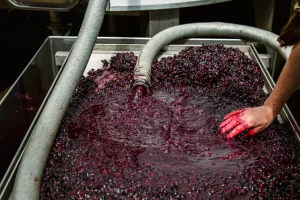Wine has been enjoyed for thousands of years, but for many, the difference between red wine and white wine, we’ll dive deep into the remains a mystery.
While both originate from fermented grapes, the two types vary significantly in color, flavor, production techniques, and even health benefits.
Whether you’re a casual drinker, a budding connoisseur, or just someone curious about their next dinner pairing, understanding the differences can enrich your wine experience.
From the grapes used to the fermentation process, each step shapes the final product you pour into your glass.
We’ll dive deep into the key differences between red and white wine, making it easier for you to choose the right bottle for any occasion.
Let’s uncork the truth behind these two beloved beverages!
The Basics: How Red and White Wine Are Made
Grape Varieties

(Image via Getty)
The most obvious distinction starts with the type of grape.
Red wines are typically made from dark-colored grape varieties like Cabernet Sauvignon, Merlot, and Pinot Noir.
White wines, on the other hand, usually come from green or yellowish grapes such as Chardonnay, Sauvignon Blanc, and Riesling.
Fun fact: Some white wines are made from red grapes by removing the skins early during production!
Skin Contact
One of the primary differences is skin contact during fermentation.
For red wine, the grape skins remain with the juice, giving the wine its deep color and rich tannins.
In white wine, the skins are quickly separated from the juice, leading to a lighter color and a crisper taste.
Flavor Profiles: Bold vs Crisp
Red Wine Flavors
Red wines are known for their bold, complex flavors.
You might notice hints of berries, cherries, plums, tobacco, or even earthy tones like leather and oak.
The tannins from the skins provide structure and can leave a dry feeling on the palate.
Popular types:
-
Cabernet Sauvignon (full-bodied, dark fruit flavors)
-
Pinot Noir (light-bodied, fruity and earthy)
White Wine Flavors
White wines are celebrated for their refreshing, bright qualities.
Common flavor notes include citrus, apple, pear, and tropical fruits, often accompanied by floral or herbal hints.
Without the tannins, white wine feels lighter and more refreshing.
Popular types:
-
Chardonnay (buttery and oaky or crisp and citrusy)
-
Sauvignon Blanc (zesty, grassy, and aromatic)
Health Benefits: Which One Wins?
Both red and white wines offer potential health benefits when consumed in moderation, but they differ slightly.
Red Wine Health Benefits
Red wine is often praised for its high concentration of resveratrol, an antioxidant found in grape skins.
Research suggests that moderate red wine consumption may support heart health by improving cholesterol levels and reducing inflammation.
White Wine Health Benefits

(Image via Getty)
While white wine has fewer antioxidants than red, it still contains beneficial compounds.
Some studies show that white wine may promote lung health and provide a lighter, lower-calorie alternative for those watching their weight.
Bottom line: Both can fit into a healthy lifestyle—but moderation is key.
Serving and Pairing Tips
Serving Temperatures
-
Red wines are best served slightly below room temperature (around 60-65°F).
-
White wines should be chilled to around 45-50°F for optimal flavor.
Food Pairings
-
Red wines pair wonderfully with hearty dishes like steak, lamb, and rich pasta sauces.
-
White wines complement lighter fare such as chicken, seafood, salads, and creamy pastas.
Tip: When in doubt, match the weight of the wine with the weight of the food!
Aging Potential: Which Lasts Longer?
Generally, red wines have greater aging potential due to their tannin content and higher phenolic compounds.
Some reds can improve over decades!
Most white wines are meant to be consumed within a few years of bottling, although notable exceptions like aged Chardonnay or Riesling exist.


